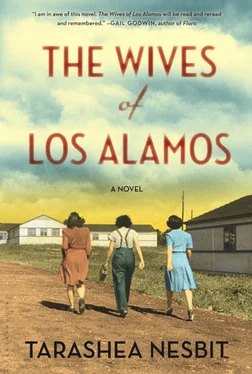WE NOW HAD help, but there were saints’ days and feast days and the days leading up to them when the girls stayed at home to prepare. Since we did not celebrate these days, we found it hard to keep track of when they occurred, and it was not easy to find out in advance how many days they would be gone. We sometimes marched into the Maid Services Office and demanded to know why no girls arrived, only to be told it was a holiday.
THEY WERE OUR nannies, our maids, and our extended family members. They did not look like us and we hated them. They seemed content and beautiful and we loved them. They were just people like anyone else and we felt thankful to have them around. They were our Florencitas and Rosalies—who gave us black pottery for Christmas, who brought us thin tortillas made from blue corn and pottery candlesticks in the shape of high pueblo boots, who left us notes apologizing that they could not wash the bedsheets because our husbands were in them.
THEY GAVE US loaves of round bread baked in their beehive ovens. They were heedless of our instructions to vacuum the Oriental rugs and instead dragged them out on the back porch and shook them above the heads of the children playing below. One of the girls asked Katherine, whom she thought of as not only her boss but her friend, to bake one of her famed stuffed chickens for a celebration. Katherine did so, but said to the rest of us: Just who is working for whom?
WE THOUGHT THEM generous and good with our children. We learned how to swaddle our babies as they did. We tutored their sons in English after school and they taught us how to make more northern New Mexico dishes—tortillas, posole, and corn cooked the Indian way. They learned to make our peanut butter sandwiches, but we never learned the delicious secret of their kapo-wano fried bread.
AS WE ATE breakfast we saw the group of women walking past the water tower and to our houses, dressed in colorful mantas tied with woven belts, high white deerskin boots or plain walking shoes, with shawls over their heads and shoulders, and so much turquoise , we told one another. Enough to stock a trading post . When we noticed that the bus delivered them an hour before the shift started, some of us invited them in for coffee on cold days. And as we made oatmeal we heard them speaking quickly and giggling in the living room, but we never found out what was so funny. Though most knew three languages—English, Spanish, and their native Tewa—many talked little to us.
OTHERS OF US made closer friendships. On her way to the dorms where she worked, Ana stopped to talk about mesa affairs. Later on, when she started taking her lunches at our house, we sat and gossiped. A few of us learned about some young Indians’ thinking: how they wanted to remain in the pueblo but desired a better life for their children than they had. How the old people wanted to keep things as they were. Ana was saving money for a new house with an inside bathroom, good heating, and an icebox like the Army provided for us. Julieta, on the other hand, resisted such improvements, considering them unnecessary.
ONE GIRL TOLD us that each time the General came to the pueblo to recruit them for work he wore khaki shorts. The tribal members gave him a Tewa nickname—a word we can’t recall—and he seemed very proud to have his own special name. What did the name mean? we asked our housekeeper. She smiled and said, The man who wears baby pants .
WHEN WE WERE invited to feast days it seemed strange to us to watch the corn dancers bring the Catholic saint from the church and place it in a shrine set up for the day, then perform the ancient dances that seemed to have no relation to Christianity. When the dancers stopped to rest, they had a choice of going into the kiva or kneeling in the shrine to pray before the saint. At sunset the dancers, still in corn dance costume, carried the saint back to the church. We asked, How can you be good Catholics and also believe in your traditional gods? Ana saw nothing strange or contradictory—this, she said, was the way it had always been. But by asking Anita, an Indian who sometimes spoke in Fuller Lodge about Indian customs, we learned of the pueblo’s two rebellions against Spanish rule and their centuries of cohabitation.
WE ASKED APOLONIA what her husband did for work. He does the hunting. Now they were buying food from the commissary, so we asked again, What does your husband do now ? She replied, I give him money. He goes to the store and buys the food. It could have been more complicated than these chosen words, there may have been things she could not or would not articulate about her relationship with her husband, but we did not press her.
SHE ASKED US what we were doing here in the desert. We said, The war . She nodded and we interpreted this as disapproval, so we said, Do you know why we are fighting? She said No , or she said Yes , but either way we could tell it did not matter. We told her a story—of surprise attacks, victims, greed. Well, what do you think of the war now? we asked, feeling we’d done a particularly good job of conveying the atrocities. She gave us a look. Her opinion had not changed.
AND WHY SHOULD it have? Were we blind to the struggles of others? First the Spaniards, then the Anglos, then the Mexicans—so many people trying to change them, kill them, and claim the land.
SOME OF US never talked to our housekeepers, or when we did we talked really slowly and really loudly. We climbed sacred mountains, stood on ceremonial structures, took arrowheads from ancient dwellings for souvenirs, and admired the views. Others of us grew protective of the petroglyphs. When Starla learned that her Henry’s favorite mushroom hunting grounds—where he gathered paper bags full of button fungi—was just below a plumed serpent carved in the rock, which could be seen well when the shadows fell, she gave him quite a scolding. Henry had never noticed it, never looked to see the numerous other carvings. Frank added that the living Indians intrigued him far more than the dead ones.
HOW MUCH DID we want them to stay exactly as we had imagined they had always been? Some of us said, over the ladies’ lunch, that others of us were going native . They were living in a past our ancestors had given up. We were women wanting the girls, who now wore attire similar to our own, to paint the most authentic images, to make the most traditional bowls. What could they do but accommodate us, their patrons.
THOUGH WE BENEFITED from their inexpensive domestic help, we still complained that the help was not enough. And it was not fair that some of the girls picked favorites, how they disliked being moved around on the chart each day, and some of us said they just went wherever they pleased anyway. We wanted more help or different help and we were told if we wanted more assistance we would need to have another baby. We complained to our husbands, but they instead tried to find solutions, or joke, rather than listen. They said, In the future there will be trained chimpanzees mopping our floors, and what the Maid Services Office really should do instead is set up an Agency of Primate Distribution.
OUR HUSBANDS PARODIED our maids in after-dinner skits; our husbands wore scarves on their heads and peasant skirts, turquoise bracelets clinking as they dusted the same table over and over again, as they pretended to be Sofia and took nips of our liquor. We laughed, we cackled, we thought it all in good fun.
BEFORE WE ARRIVED at Los Alamos as wives and mothers we had been teachers in Seattle, housewives in New Jersey, watercolorists in Nebraska, writers in Des Moines, chemists at Harvard, and one of us had been a dancer in the Chicago ballet. Ingrid, Marie, Pauline, and Marjorie all had B.S.s in mathematics with minors in home economics. We were halfway through school when our husbands asked us to marry them, and it didn’t seem there was a point in continuing: few married women had careers, and our family did not need the extra income. Or we had once wanted to pursue doctoral degrees but were told by our male mentors during our senior year of college, There is no place in higher mathematics for women, no matter how brilliant. Some of us were told, The universities won’t want you, and you’ll be overqualified to teach high school. Many of us did not pursue a doctoral degree but married a man who got one instead. But a couple of us were encouraged to keep going, or kept going despite what our mentors told us, and we, too, became doctors.
Читать дальше












